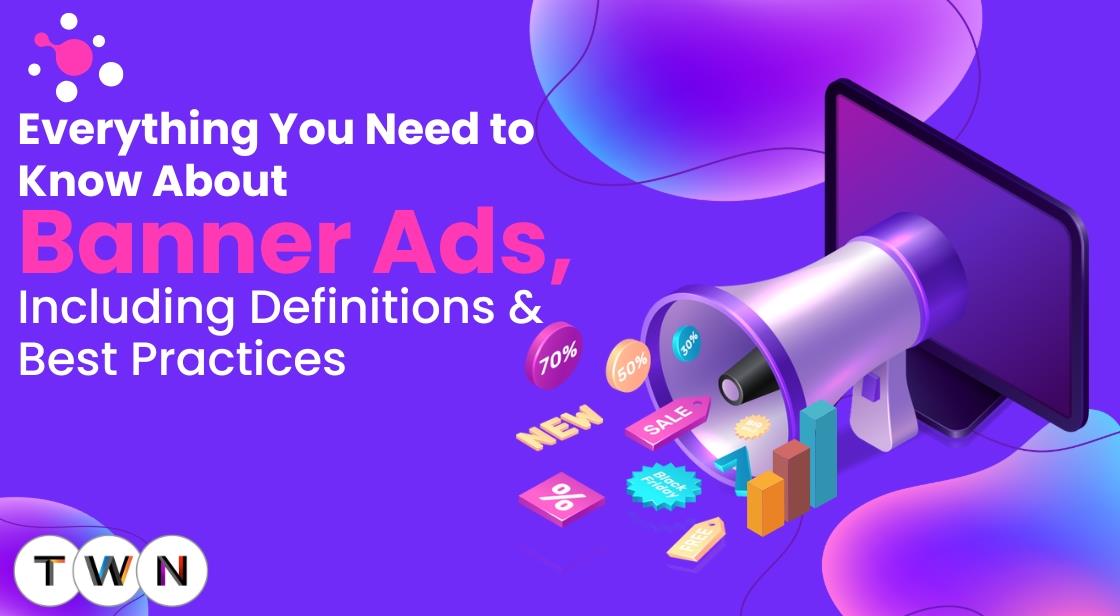Everything You Need to Know About Banner Ads, Including Definitions and Best Practices

Blog Post
Banner ads are one of the most widely used forms of online advertising, designed to capture attention, engage viewers, and drive actions like clicks or conversions. With the increasing competition for user attention in the digital space, creating effective banner ads requires more than just eye-catching graphics—it involves strategic planning, targeted messaging, and ongoing optimization.
These ads can appear in various formats, including static images, animated sequences, or even interactive elements, allowing brands to showcase products, services, or special offers to their target audiences. However, simply designing a banner isn’t enough; success hinges on following key best practices that maximize engagement and conversion rates.
From choosing the right visual elements and placing brand logos to offering a clear value proposition and selecting optimal formats, there are several factors to consider. Additionally, using animations wisely, conducting A/B testing, and continuously monitoring performance are essential steps in refining banner ads and achieving higher returns on investment.
This blog will explore banner ads in detail, covering their different types, how they work, and the top best practices for creating impactful and engaging ads that effectively capture the audience’s attention and encourage meaningful interaction.
Exploring Banner Ads Through Definitions, Examples, and Top Best Practices
What Is a Banner Ad?
A banner ad is a type of online advertising that features visually engaging graphics displayed on websites. These ads aim to attract users' attention and encourage them to click through to the advertiser’s site or a specific landing page. Banner ads come in various formats and sizes, ranging from static images to animated graphics. Vertical banners are commonly referred to as "skyscrapers," while horizontal ones are known as "leaderboards." Banner ads are typically used to promote products, services, events, or to enhance brand awareness. The effectiveness of these ads depends largely on their design, strategic placement on the webpage, and their relevance to the target audience.
How Banner Ads Work
Banner ads are a widely-used form of online advertising, leveraging graphic elements to engage users and drive specific actions. Below is a breakdown of how these ads function, from creation to targeting.
1. Ad Creation
The first step in banner advertising is to create visually appealing ads that incorporate images, text, and sometimes interactive elements. The design of the banner is crucial, as it needs to capture users’ attention while effectively communicating a clear and concise message about the product or service being promoted. High-quality graphics, a strong call to action, and branding elements are typically used to entice potential customers.
2. Ad Placement
After the ad is created, advertisers strategically place it on websites or platforms where their target audience is likely to visit. Common ad placements include at the top of the page (above the content), within sidebars, or even between paragraphs of text. When a user visits a site that features the banner ad, the ad is dynamically fetched from an ad server and displayed in real-time on the user’s screen. Placement in high-visibility areas maximizes the chances of user engagement.
3. User Interaction
Most banner ads include a clickable element, such as a button or a call to action (CTA), urging users to take specific actions like visiting the advertiser’s website. When clicked, users are redirected to a landing page where they can learn more about the product or service, make a purchase, or perform another desired action. Payment for banner ads is generally structured through three main models:
-
Cost Per Click (CPC): Payment is made when a user clicks the ad.
-
Cost Per Impression (CPM): Payment is made per thousand views.
-
Cost Per Action (CPA): Payment is made when a user completes a specific action, such as making a purchase or signing up for a service.
4. Analytics
Advertisers track the success of banner ads by analyzing metrics such as click-through rates (CTR), impressions, and conversions. These data points provide insights into how well the ad campaign is performing, allowing advertisers to make adjustments and optimize their strategies for better results.
5. Targeting
Targeting is key to banner ad success. Advertisers typically focus on users based on their demographics, interests, or online browsing behavior. This ensures that ads are shown to users who are more likely to be interested in the advertised product or service. Retargeting is often used to re-engage users who previously interacted with an ad but did not complete a desired action, such as making a purchase.
By combining compelling design, effective placement, and smart targeting, banner ads can successfully drive engagement and achieve the advertiser’s goals.
Types of Banner Ads
Banner ads come in various forms, each offering unique ways to engage users. Let’s explore the most common types of banner ads:
1. Static Banner Ads
Static banner ads consist of non-moving, single-image designs that deliver a straightforward message. They are perfect for promoting brand awareness, showcasing a product, or delivering a clear call to action. Due to their simplicity, static banners capture attention in just a glance, making the message easy to understand without the distraction of motion or animation. These ads are ideal for situations where clarity and directness are key.
2. Animated Banner Ads
Animated banner ads incorporate movement through effects like fading, sliding, or rotating elements. This animation helps create a more dynamic and visually appealing experience. Unlike static ads, animated banners can tell a brief story or highlight multiple features in the same space. These ads are effective at grabbing attention, promoting multiple offers, or conveying a sense of urgency. They strike a balance between simplicity and engagement by using moving elements to enhance the user experience without overwhelming them.
3. Video Banner Ads
Video banner ads utilize short video clips embedded within the banner space. These ads can automatically play when the page loads or upon user interaction. The use of video and sound allows advertisers to engage viewers with audiovisual storytelling, showcasing product features, or delivering memorable brand messages. Video banners are particularly effective for capturing attention and demonstrating product use within a short timeframe, creating a more immersive experience compared to static or animated ads.
4. Interactive Banner Ads
Interactive banner ads encourage users to engage with the content through clickable elements, hover effects, or even mini-games. These ads are designed to actively involve the viewer, making them more interactive participants rather than passive observers. A notable example is Mazda’s “Challenge the Night” campaign, where users could control a car and discover its features through a game. Interactive ads offer an immersive experience that can effectively highlight product features or encourage exploration of brand content.
5. Transitional Banner Ads
Transitional banner ads change or adapt based on user interaction. Two common types include expandable and floating banners:
-
Expandable Banners: These ads start small and expand when the user interacts with them. This allows the advertiser to present additional information without overwhelming the user at first sight. The expansion offers more content while keeping the initial design minimal.
-
Floating Banners: Floating banners move across the screen as the user scrolls, ensuring that the ad remains visible and engaging as the user navigates through a webpage. This format captures attention by following the user’s line of sight.
Each of these banner types serves different purposes, from delivering a simple message to creating engaging, interactive experiences.
Best Practices for Effective Banner Ads
Banner ads are a vital component of digital marketing, providing an effective way to attract attention and engage audiences. Below are some best practices to ensure your banner ads deliver optimal results.
1. Use High-Quality Visuals
The visual appeal of your banner ad plays a crucial role in capturing your audience's attention. High-quality, visually appealing images or graphics can make your ad stand out from the competition. Always ensure that the images used are high-resolution and professionally designed to reflect the quality of your brand. The graphics should align with your overall brand identity and evoke the right emotional response from your target audience.
2. Place a Logo
Including your brand’s logo on every banner ad is essential for brand recognition. Your logo helps create a consistent identity across all your marketing materials and allows users to quickly associate the ad with your business. The more frequently your audience sees your logo in various contexts, the stronger your brand recall will be. Additionally, a consistent presence of your logo across platforms helps reinforce trust and reliability, encouraging users to engage more readily with your ads.
3. Have a Clear Value Proposition
With countless advertisements vying for attention, having a clear and compelling value proposition is key to making your banner ad effective. Your value proposition should immediately communicate why a user should click on your ad. Whether you are offering a discount, free shipping, or a product feature that sets you apart from competitors, make sure these benefits are obvious. Ask yourself:
-
What product or service are you promoting?
-
What exciting features or offers can you highlight?
-
Are there any time-sensitive promotions like discounts or free trials? Clearly stating your value proposition helps you stand out in the crowded digital space and increases the likelihood of a user clicking through to learn more.
4. Choose a Format and Size
Banner ads come in various formats and sizes, and selecting the right one for your campaign is crucial. The most common formats include:
-
Leaderboard: A horizontal ad that appears at the top or bottom of a webpage. Its prominent placement ensures maximum visibility and high engagement.
-
Skyscraper: A vertical ad format typically placed along the sides of a webpage. These ads are often seen in sidebars or menus, giving them extended visibility as users scroll.
-
Square: A balanced, square-shaped ad format that fits well within the design of most webpages. Google’s responsive ads provide additional flexibility by adjusting their format and size to fit available ad spaces on the Display Network. By uploading assets such as headlines, logos, and images, you can allow Google to automatically optimize your ads for different platforms, ensuring they are displayed effectively.
5. Use Animations Wisely
Animated banner ads tend to outperform static ones by driving higher engagement, recall, and click-through rates. Research shows that animated banners can boost conversion rates by an average of 7%. However, it’s essential to use animations thoughtfully. Overly complex or distracting animations may take away from your ad’s core message. Instead, opt for subtle animations, such as gentle fades or simple product showcases that attract attention without overwhelming the user. For example, an animation showcasing rotating product images or a short loop of a service in action can increase user engagement while keeping the focus on your value proposition.
6. Conduct A/B Testing
A/B testing, or split testing, is critical for identifying the most effective elements of your banner ad campaigns. By experimenting with different versions of your ads, such as varying the headline, images, or background colors, you can determine what resonates best with your audience. Tracking key performance indicators such as click-through rates (CTR), conversions, and user engagement allows you to refine your strategy. For example, if one version of your ad significantly outperforms another, you can use these insights to inform future campaigns and continually improve ad performance.
7. Monitor Performance and Optimize
Once your ads are live, it’s essential to monitor their performance regularly. Pay attention to metrics such as impressions, CTR, and conversion rates to gauge how well your banner ads are performing. If certain ads aren't meeting your expectations, experiment with changes in design, copy, or placement. Using tools like Google Ads or other ad management platforms can provide valuable insights into how your ads are interacting with your target audience. Continuous optimization based on real-time data helps maximize the effectiveness of your campaigns and ensures you get the best possible return on investment.
How much does banner advertising cost
The cost of banner advertising can vary significantly based on several factors, including the ad network, the type of banner ad, placement, and target audience. Here’s a breakdown of the typical pricing models and average costs:
Cost Per Impression (CPM):
-
This model charges advertisers based on the number of times the ad is displayed, typically calculated per 1,000 impressions.
-
Average CPM rates can range from $1 to $10, depending on the website's traffic and audience demographics.
Cost Per Click (CPC):
-
In this model, advertisers pay each time a user clicks on their banner ad.
-
Average CPC rates usually fall between $0.20 and $2.00, but can be higher for competitive industries.
Cost Per Action (CPA):
-
This pricing structure charges advertisers only when a user takes a specific action, such as making a purchase or signing up for a newsletter.
-
CPA costs can vary widely, often ranging from $10 to $100 or more, depending on the value of the action being encouraged.
Flat Rate:
-
Some websites offer flat-rate pricing for a specific period, allowing advertisers to purchase ad space for a predetermined fee.
-
This can range from a few hundred to several thousand dollars, depending on the site's popularity and audience reach.
Programmatic Advertising:
-
In programmatic advertising, costs are determined by real-time bidding systems, which can fluctuate based on demand and competition.
-
This model allows advertisers to set budgets and bid for ad placements.
Conclusion
Banner ads remain a cornerstone of online advertising, offering businesses a versatile and visually engaging way to connect with their target audiences. By understanding the different types of banner ads—static, animated, video, interactive, and transitional—advertisers can tailor their campaigns to achieve specific goals, whether it’s increasing brand awareness, driving website traffic, or boosting conversions.
Success in banner advertising hinges on several key elements: creating high-quality visuals, using strategic ad placements, developing clear and compelling value propositions, and leveraging effective targeting methods. Moreover, best practices such as A/B testing, continuous performance monitoring, and optimization ensure that campaigns remain impactful and deliver maximum return on investment.
Cost considerations also play a significant role, with advertisers choosing pricing models like CPM, CPC, CPA, or flat-rate options based on their budget and objectives. Programmatic advertising further enhances efficiency by using real-time bidding systems to target audiences precisely.
In an ever-evolving digital landscape, the combination of creative design, data-driven strategies, and innovative formats ensures that banner ads continue to be a powerful tool in the marketer’s toolkit. When executed thoughtfully, they have the potential to not only capture attention but also foster meaningful engagement and drive measurable business outcomes.
You May Like
EDITOR’S CHOICE












